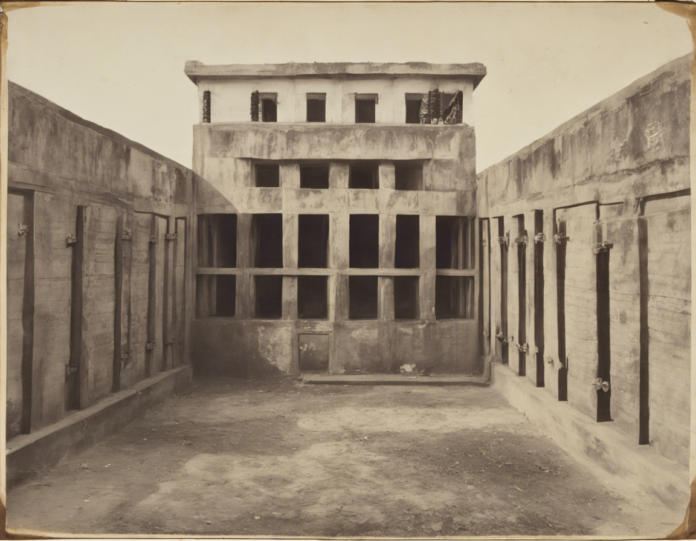Introduction
The cellular jail, famously known as Kala Pani Jail, holds a significant position in the history of colonial India. Located in the Andaman Islands, this infamous prison served as a tool for the British to exile political prisoners and suppress the freedom movement during their reign. The name “Kala Pani” itself evokes a sense of fear and dread due to the brutal treatment meted out to inmates. In this article, we will delve into the history, construction, conditions, and the eventual closure of Kala Pani Jail, shedding light on the grim reality faced by prisoners within its confines.
History of Kala Pani Jail
Kala Pani Jail was built in the late 19th century by the British colonial rulers. The primary objective behind its construction was to exile political prisoners and revolutionaries who posed a threat to British rule in India. The isolation of the Andaman Islands made it an ideal location for such a prison, as escape was nearly impossible, and prisoners were effectively cut off from the mainland.
Construction and Design
The design of Kala Pani Jail was unique and cruel. It consisted of individual cells arranged in a radial pattern, with a central watchtower allowing guards to keep a close eye on all the inmates. The cells were small, dark, and poorly ventilated, with minimal facilities for basic hygiene. Prisoners were subjected to harsh living conditions, including forced labor and meager rations, making survival a daily struggle.
Conditions Inside the Jail
Life inside Kala Pani Jail was grueling and inhumane. Prisoners were subjected to physical and mental torture, including solitary confinement, beatings, and deprivation of food and water. Many inmates succumbed to diseases such as malaria and dysentery due to unhygienic conditions and lack of medical care. The harsh regime and brutal treatment inflicted upon prisoners earned Kala Pani Jail a fearsome reputation as a place of unspeakable suffering and despair.
Revolt and Closure
Despite the oppression they faced, the inmates of Kala Pani Jail did not submit meekly to their fate. Several revolts and uprisings took place within the prison walls, with prisoners daring to challenge their oppressors and demand better treatment. The spirit of resistance among the inmates eventually led to the gradual decline of the prison, and it was finally closed down in the mid-20th century as India gained independence from British rule.
Legacy of Kala Pani Jail
The legacy of Kala Pani Jail serves as a reminder of the dark chapters of India’s history under colonial rule. It stands as a symbol of the sacrifices made by freedom fighters and revolutionaries who endured unimaginable hardships in the pursuit of independence. The stories of courage and resilience exhibited by the inmates of Kala Pani Jail continue to inspire generations to uphold the values of freedom, justice, and dignity.
Conclusion
In conclusion, Kala Pani Jail remains a poignant reminder of the atrocities committed during the colonial era and the resilience of those who fought against oppression. The harsh conditions, brutal treatment, and eventual closure of the prison symbolize the triumph of the human spirit over adversity. As we reflect on the history of Kala Pani Jail, let us not forget the sacrifices made by the brave souls who languished within its walls, their legacy forever etched in the annals of India’s struggle for freedom.
Frequently Asked Questions (FAQs)
- What was the significance of Kala Pani Jail in India’s freedom movement?
-
Answer: Kala Pani Jail served as a tool for the British to exile political prisoners and suppress the freedom movement in India, making it a symbol of colonial oppression.
-
How were prisoners treated in Kala Pani Jail?
-
Answer: Prisoners in Kala Pani Jail were subjected to brutal living conditions, including forced labor, solitary confinement, and inadequate food and water.
-
Why was Kala Pani Jail finally closed down?
-
Answer: The gradual decline of Kala Pani Jail was due to the spirit of resistance among the inmates and the eventual independence of India from British rule.
-
What is the legacy of Kala Pani Jail today?
-
Answer: The legacy of Kala Pani Jail serves as a reminder of India’s struggle for independence and the sacrifices made by freedom fighters during the colonial era.
-
Are there any efforts to preserve Kala Pani Jail as a historical site?
-
Answer: While there have been calls to preserve Kala Pani Jail as a historical site, its dilapidated state and grim past make it a challenging endeavor.
-
How did inmates communicate with each other in Kala Pani Jail?
-
Answer: Inmates in Kala Pani Jail devised creative ways to communicate, such as using coded messages, tapping on walls, and passing messages discreetly during their brief moments of interaction.
-
Were there any notable individuals who were incarcerated in Kala Pani Jail?
-
Answer: Several prominent freedom fighters and revolutionaries, including Veer Savarkar and Batukeshwar Dutt, were held captive in Kala Pani Jail for their role in the independence movement.
-
What were the living conditions like for prisoners in Kala Pani Jail?
-
Answer: Prisoners in Kala Pani Jail endured overcrowded and unhygienic conditions, with limited access to sunlight, fresh air, and proper sanitation facilities.
-
How has the story of Kala Pani Jail been portrayed in literature and films?
-
Answer: The grim reality of Kala Pani Jail has been depicted in various literary works and films, showcasing the horrors faced by inmates and the resilience displayed in the face of adversity.
-
What measures have been taken to commemorate the history of Kala Pani Jail?
- Answer: Efforts have been made to preserve the memory of Kala Pani Jail through museums, memorials, and educational initiatives that highlight its role in India’s struggle for independence.




